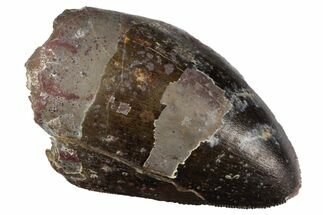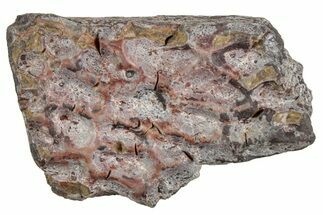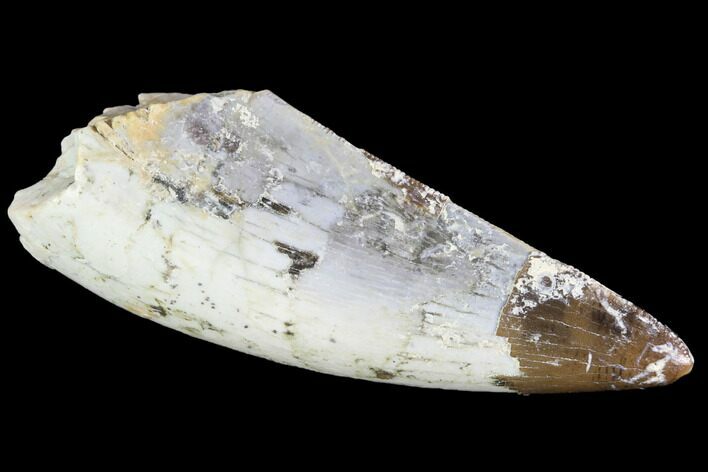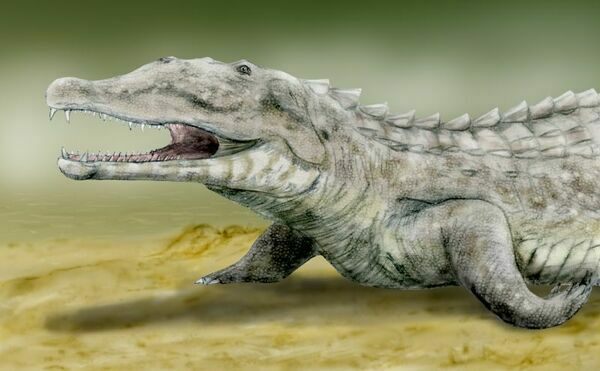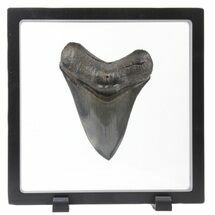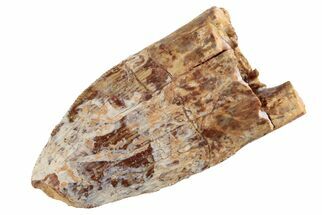This Specimen has been sold.
Large, Serrated, 1.67" Fossil Phytosaur Tooth - Arizona
This is a 1.67" long, serrated tooth of a Triassic Phytosaur (Leptosuchus?) collected this fall from the Chinle Formation of Arizona. Most of the enamel is worn and there are a few repaired cracks but it is a large tooth.
Comes with a floating frame display case.
Comes with a floating frame display case.
Phytosaurs are members of the order Phytosauria. These were semiaquatic, crocodile-like reptiles characterized by long snouts, conical teeth, short legs, heavy tails, and long, low-slung bodies. They also had skin armored with scale-like scutes. However, Phytosaurs are not related to modern Crocodilians. The similarities are an example of parallel evolution, where two different species develop similar characteristics and attributes without a common ancestor.
It is not clearly understood when Phytosaurus evolved, but a number of apparently antecedent species have been found in the fossil record: their relationship to Phytosaurs is still debated. Phytosaurus disappears from the fossil record during the Triassic-Jurassic Extinction, about 200 million years ago.
Generally, Phytosaurs looked like modern crocodilians. Some species had longer, thinner snouts with thin conical teeth for catching fish, while others had comparatively shorter, wider snouts with conical teeth in the front and ripping teeth in the back of the mouth. These were likely ambush hunters that snatched prey at the water’s edge, much like modern crocodiles. The longest known Phytosaur was 39 feet long and would have been about as tall as a human at the top of its back. Unlike modern Crocodilians, whose nostrils are at the end of their snouts, Phytosauria had their nostrils at the bases of their snouts, just above or at the same level as their eyes.
Phytosaurs were nearly globally distributed. The result is phytosaur fossils have been found in Europe, North America, India, Thailand, Brazil, Greenland and even Antarctica.
It is not clearly understood when Phytosaurus evolved, but a number of apparently antecedent species have been found in the fossil record: their relationship to Phytosaurs is still debated. Phytosaurus disappears from the fossil record during the Triassic-Jurassic Extinction, about 200 million years ago.
Generally, Phytosaurs looked like modern crocodilians. Some species had longer, thinner snouts with thin conical teeth for catching fish, while others had comparatively shorter, wider snouts with conical teeth in the front and ripping teeth in the back of the mouth. These were likely ambush hunters that snatched prey at the water’s edge, much like modern crocodiles. The longest known Phytosaur was 39 feet long and would have been about as tall as a human at the top of its back. Unlike modern Crocodilians, whose nostrils are at the end of their snouts, Phytosauria had their nostrils at the bases of their snouts, just above or at the same level as their eyes.
Phytosaurs were nearly globally distributed. The result is phytosaur fossils have been found in Europe, North America, India, Thailand, Brazil, Greenland and even Antarctica.
SPECIES
Leptosuchus?
LOCATION
Private Range, Northeast Arizona
FORMATION
Chinle Formation
SIZE
1.67" long
CATEGORY
SUB CATEGORY
ITEM
#88601
We guarantee the authenticity of all of our specimens.
 Reviews
Reviews

